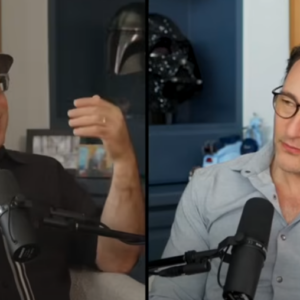Articles
Inside Legitimate Leadership’s Recent London Workshop
October 29, 2025 - By Chris Le’cand-Harwood, Founder, Content Marketing PodShare by Email
“I’d do this in a field with a flip chart if I could,” said Sean Hagger of Legitimate Leadership, reflecting on his passion for Legitimate Leadership workshops – and why he’s happy to set a 5am alarm to facilitate them.
In other words, it’s not just about the venue – he would do them anywhere. It’s about the content, the conversation, and the transformation that happens when leaders pause to truly examine how they lead.
Legitimate Leadership’s two-day workshop in London in September, which Sean led, brought together leaders ready to move beyond command-and-control approaches and discover what genuine, legitimate leadership looks like in practice.
A Day Behind The Scenes
We followed Sean at the London workshop to capture what it takes to create the conditions for leadership breakthroughs. And we spoke to others who took part in the workshop.
What struck us the most? Sean’s perspective on his role:
“You don’t feel like you own this. You feel like you are a conduit to give it to other people. That’s quite a responsibility, and I take it seriously.”
This isn’t about delivering content. It’s about being a guide for leaders facing a tough job.
The Shift That Changes Everything
Leadership development often stays theoretical. Pie charts and bar charts that look impressive but don’t translate into action.
The Legitimate Leadership Framework is different. As Will Grocott, a participant, said: “What are you going to do on Monday that’s different to what you’ve been doing previously? If nothing changes, nothing changes.”
Ian Munro, MD of Legitimate Leadership, said the fundamental transformation sought in these workshops is: moving leaders from “I give to get” into a world where people give because they’re values-aligned.
But leaders can’t ask their teams to make this shift without making it themselves first.
Said Ian: “The process of leading requires that you too make that shift from being conditional to doing things for the right reasons.”
The Power Of Self-Reflection
Ashley Parkinson, a participant, said: “The training has taught me that first of all, I need to look internally. What have I been doing wrong and what can be done right?”
The breakthrough? Ashley discovered that instincts about leadership weren’t “random strange thoughts” – they were valid insights that just needed validation and a framework to act on them.
Ashley’s approach moving forward to achieve sustainable leadership change: start with small steps, build on early successes, and use those wins as foundations for bigger transformations.
From Why To How – Closing The Gap
Ria Bailes, another workshop participant, captured something Legitimate Leadership sees constantly: “We all know that the ‘why’ is really important. But then work and life just take over and in the moment we jump straight into the ‘how’.”
Ria said the workshop gave her space to think through various situations before facing them in real time. “These are simple things you can do, but it just takes a couple of seconds to think about doing them,” she said.
That’s what separates reactive leadership from intentional leadership.
The Accountability Paradox
Sean highlighted one of the most challenging leadership paradoxes: the relationship between care and accountability.
“You go out and put all this time and energy into caring for someone, and then suddenly they do something slightly under the standards expected … and we get to the cliff edge and go, ‘I don’t want to risk that relationship’.”
The result? High care, low growth = crashed morale.
Why does morale crash when leaders care but won’t hold standards? Because people know when standards are slipping, and they lose respect for leaders who won’t address it.
The courage to hold high standards is caring. It’s saying, “I believe in you enough to challenge you.”
Understanding What Comes Before Accountability
Ian broke down a critical issue many leaders face: jumping straight to accountability without establishing the foundation.
“You can’t hold people accountable for things they didn’t know about in the first place. You can’t hold people accountable for failing to do work when there’s too much work to be done.”
His approach is clear:
- Start with care – this gives you the license to grow.
- Then address means – do they have what they need?
- Then check-ability – can they actually do it?
- Only then, ramp up accountability – now it’s fair and effective.
When leaders understand this sequence, accountability becomes a natural conversation rather than a confrontation.
Simplicity That Actually Works
Tony Ogden of Legitimate Leadership highlighted what makes the framework immediately usable: “You can deploy it without having to do huge sets of analysis or extensive consultation exercises. Once you’ve got the ideas in your mind, you can start making progress on day one.”
Day one – not after months of planning or extensive analysis.
The best frameworks are ones which leaders actually use in the moment, with real people, facing real challenges.
The Ripple Effect
What motivates Legitimate Leadership practitioners to do this work?
Said Sean: “When you talk to people who haven’t experienced it before and you see the light bulbs going on … maybe I’ve helped these people; maybe they can go back Monday morning and make a difference to somebody else. To me that’s intrinsically motivating.”
It’s the ripple effect. One facilitator helps a room of leaders. Those leaders return to their organisations and help their teams. Those teams create better experiences for others.
Why In-Person Workshops Like These Still Matter
We love a good leadership podcast and YouTube video. But as Ashley Parkinson, a participant, pointed out: “How many times have you sat there listening and had a question you really would like to have asked, or would like to have had your perspective challenged?”
In our workshops, you get:
- Real-time dialogue with experienced practitioners.
- Two-way challenge – push back on ideas and have yours challenged too.
- Real-world experience from people who’ve “been there, done it, got the t-shirt”.
- Personalised exploration of the issues that matter to your context.
It’s a two-way conversation where you can discuss and explore, based on real-world experiences. That’s what you can’t get from consuming content alone.
The Investment That Compounds
Said Ashley: “The best investment you’ll ever make is to invest in yourself. You could put this course money in a high interest account and get next to nothing back. But the skills I learned? I’m applying them on Monday.”
The difference is striking:
- Financial investment: passive returns that barely beat inflation.
- Self-investment: active returns that compound forever.
The skills don’t just make you a better manager. They serve you everywhere life takes you – professionally and personally.
Looking Forward
Sean’s 5am alarm, the sunrise drive to the station, the train into London, and a full day of facilitation.
Worth it?
Said Sean: “Leadership is lonely and hard. The times we get it wrong are usually when we choose the easy path over the right path. Sometimes you need a guide for that.”
Because leadership matters. The leader you become affects everyone around you. And sometimes, you need space away from the daily pressures to truly examine how you lead and who you want to become as a leader.







